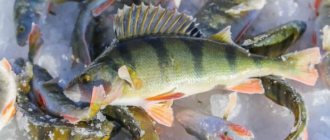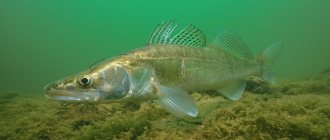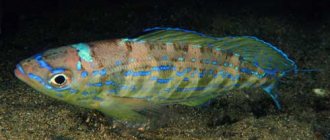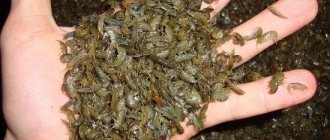Historical reference
According to the classification of L.P. Sabaneev, a Russian zoologist and organizer of the fishing industry, in different regions of the Russian Empire of the 19th century, bleak was called differently:
- baklya, bakleshka - in the Saratov province;
- verkhoplavka, verkhovodka - in Tver and Serpukhov;
- the name “sintya”, “sentya”, “sentyavka” was used by residents of Tatarstan and the Ulyanovsk region.
- “Sibil”, “sebel”, “sibel” are still used by experienced fishermen of the Rostov, Bryansk, Kursk, Voronezh regions, Lugansk region in Ukraine and Gomel region in Belarus.
Gallery: bleak fish (25 photos)
Description
External features
The body of the sticker is elongated, narrow, laterally compressed, light silver metallic in color, sparkling beautifully in the sun’s rays. Its peculiarity is its thin soft scales , which are easily separated from the body and remain on the fisherman’s hands, literally pasting them over. The name of the fish is probably related to this fact. The back of the fish is dark, the fins are light, almost transparent. The lower jaw is curved upward. The weight reaches 60 grams, but there are also individuals weighing 100 grams.
Habitats
Bleak lives in bodies of fresh or brackish water , such as river mouths. It is found in the rivers of the Azov, Baltic, Caspian, White Seas, lakes and ponds of the European part of Russia, in the Crimea and the Caucasus, in the rivers of France and Germany.
Schools of bleak usually stay in thickets of reeds and reeds, in the upper layers of water at a depth of no more than 0.7 m. On a clear day, they are easy to see near the surface. name verkhovodka came from .
During daylight hours, the bleak is constantly on the move, scurrying around in search of food, freezing in the grass thickets only at night.
Elusive Verkhovna
04/06/2016 Everyone knows Verkhovka. But when it comes to catching it, a bearded joke about Elusive Joe immediately comes to mind, who is elusive because no one needs him. Meanwhile, sometimes it’s not a sin to hunt for the Verkhovka on purpose.
Quite often, especially for a city dweller, it happens that you want to sit over a hole, but there is no fish pond nearby: there is only a rotan quarry near the house. But, to be honest, many people consider it shameful to catch rotan - such is the reputation of this invader. “Anything but a bull!” Well, if anything, try to catch the verkhovka.
Not the best replacement, would you say? Well, it depends on how you look at it. If for you the beauty of fishing comes down to kilograms or trophies, then of course. If you need excitement, then this nondescript fish is quite suitable. Moreover, despite all its apparent primitiveness, it is not so easy to catch it. The illusion of lightness, apparently, comes from the fact that sometimes it comes uninvited. In summer. Is the verkhovka often found in the “bycatch” in winter? That's it. And why?
But before you start hunting, it would be good to know the “game” by sight. The appearance of the verkhovka is known to everyone, and although it is sometimes incorrectly called bleak, they mean precisely this representative of the domestic ichthyofauna. So, the average height is 5-6 centimeters. Average weight - ... your arm will dry up to gain kilograms. But there are so many advantages. Firstly, the fish are schooling, which means you don’t have to collect them individually from the holes. I fell into a herd of verkhovkas, was able to hold on, and more than a dozen fish are guaranteed. And how many unfulfilled bites! Secondly, the fish is not shy. I have fished with a line length of only 30 centimeters. What other fish will let your hand reach such a distance? In addition to the purely utilitarian speed of fishing, it is also visual contact. I confess that sometimes I put down my fishing rod and just watch what these fast fish do with the crumbs of bait. By the way, you can show children such an aquarium in a hole.
And finally, purely practical benefits. Personally, I came to fishing for verkhovka by accident. I just somehow assembled a fishing rod with a cobweb fishing line and an appropriate nod. It was necessary to check how this thing would work. Of course, you can also play with a jig in a jar of water. But surely any of us has come across a situation where at home the tackle behaves quite decently, but on a pond you can’t even push a jig into the water. Such stubbornness is shown exclusively by representatives of the lightest weight category, intended for fishing in shallow or upper layers of water. And the nearest quarry or pond is exactly the testing ground that is needed for testing.
And the top dog, in my opinion, is an almost ideal training object. There is no threat of line breakage “on a fish” at all: the mass of prey does not imply this. “Bycatch” in the form of other fish is also practically impossible. The crucian carp that lives in such reservoirs has already fallen onto the side, and rare exceptions to the rule do not count. Rotan, although still awake, remains, for the most part, in other places and horizons. And, again, he has the wrong weight and the wrong agility to tear the tackle at this time. Therefore, you can safely test even fishing lines less than five hundredths, which have already appeared in stores.
On the other hand, with such minimal dimensions, the mouth of the verkhovka is quite comparable in size to the corresponding part of the body of a roach that is quite decent by winter standards. This means that jigs can be used not only with millet grains. Although it is precisely for the sake of testing micro-baits that it is worth hunting for the verkhovka.
Another point is the bite. Actually, there are two possible options here. On the first ice the Verkhovka takes it sharply and quickly, like a dog bites. If you take into account the shallow depth and miniature size of the gear, then this behavior is simply a gift. It is no secret that winter fishermen, who have become unaccustomed to the gear during the summer period of inactivity, often suffer from the quality of their hooking in such conditions.
The result is torn fishing lines and fish lips. A dozen or two caught verkhovkas allow you to “restore your hand.” And here not only purely mechanical skill comes into play, but also the absence of fever: the trophy, you know, is not something to get excited about.
The verkhovna bites in a completely different way closer to January. The oxygen regime in small closed reservoirs changes greatly by this time. It's not hard to guess that it's not for the better. Accordingly, along with oxygen, the agility of the inhabitants of the reservoir, including the verkhovka, also decreases. Here its bite is already similar to the furtive bite of a roach in the middle of nowhere. Priorities regarding bait also change. In particular, their dimensions. The most elegant tackle, extremely finely tuned, is required. And sometimes you can catch a verkhovka only with a float rod and exclusively with a stern bloodworm. Does this remind you of anything? That's right, the same roach. And therefore, if it is not possible to go out for full-fledged fishing, it makes sense to practice on the top.
If convinced, then here are some practical recommendations. It’s clear with the tackle: we’re working on roach. Corresponding attachments: bloodworm and Chernobyl. Plus to this - “chatter”, dough and pasta. This little fish doesn’t refuse them either. And, by the way, she’s not the only one.
Wiring depends on the season: the deeper the winter, the slower it is, up to a standstill. And in general, the Verkhovna does not like perch shaking. After all, the fish is white, noble, and not some kind of predator.
As for the location, here the verkhovka copies the behavior of the bleak. Usually it stands at half-water or higher above some fairly large hole. Only in the first ice do small flocks still roam on the border between the depths and the shallows. But they soon join the main herd. Moreover, each pit has its own company. And the larger the local “Mariinskaya Trench”, the more fish gather above it.
The standing horizon depends on both the month and the weather. The thicker the ice and the more snow on it, the deeper the flock descends. There is a corresponding reaction to pressure. And vice versa: in November, and even if it’s sunny, the verkhovka comes straight from under the ice. At this time, she is so active that, in pursuit of bloodworms, she boldly enters directly into the hole and even pecks in it. And if you sit quietly, you can see purely summer behavior, when the bait scattered on the surface of the water will disappear in the mouth of this fish.
Any bait is suitable, from primitive bran and breading to the most sophisticated. The main condition for feeding is again similar to feeding bleak: often, but little by little. The fact is that despite the fact that the flock is quite large, it does not have time to quickly pick up everything that falls from the sky. As a result, part of the feed goes deeper, right down to the bottom. And its column becomes wide even in a stagnant body of water, which naturally disperses the fish and worsens the bite.
Of course, observance of one more rule, common to any fish: the weaker the bite and the more passive its potential consumer, the less any edibles should fall into the hole. For example, in December, a tablespoon of crackers is enough for me for a couple of hours of fishing.
So don't waste your breading in vain. It will be useful to you when you come back from the pond with your catch. Verkhovka fried in breadcrumbs until crusty is a completely edible dish. You can also make sprats. Or pickle it in strong brine, dry it and husk it like sunflower seeds. So it was in vain that Mr. Sabaneev wrote that verkhovka “is not used as food.” We use everything.
But in the sense of using the verkhovka as live bait, Leonid Pavlovich was right. Moreover, not only in summer, but also in winter, I brought her home safe and sound. Moreover, one verkhovka caught in January lived in my three-liter jar until the ice melted and was safely released into its native pond. But looking at her delicate appearance, you cannot say that she can be so tenacious.
Finally, one last point to note. If in the middle of winter a redfish suddenly appears under the ice near a hole, but refuses to bite, this is a sure sign of imminent death. In principle, this should be reported to the fishery inspectorate, and it should take measures to preserve the fish. In theory. However, that's another topic
Sergey RYABIN
We are on Google+ Fisherman-Fisherman
| Author | Sergey Ryabin, Noginsk, Moscow region |
| Issue number | 4/2016 |
| Read the article | 8484 |
Rating: 3.3
Nutrition
Despite its small size, the bleak is quite voracious. Its main delicacy is flies and other insects, plankton, eggs, larvae, and fry. Sometimes after sunset you can see how a bleak jumps out of the water: first it moves in one direction and the other, then sharply turns over on its side, bends its body, hits the water with its tail and, having described a semicircle in the air, falls back into the water. This technique is aimed at obtaining food: at this time, clouds of mosquitoes and midges swarm near the water, sprayed with water, they fall to the surface, where they become prey for fish. In the same way, bleak acts when it sees a predator, perch, pike or asp, who like to feast on small fish.
Keeping verkhovka in the aquarium
The top swimmer does not tolerate loneliness well, so it is better to purchase a whole school at once - 5-10 small fish. This will make it easier for them to adapt to new living conditions. During the day, the verkhovna floats on the surface of the aquarium, and at night it is located on the bottom.
Fish often jump out of the tank, so the aquarium should be filled only halfway or covered with a glass lid on top. The recommended tank volume for this type of fish is 30-40 liters. The water must be clean and oxygenated. It is important to adhere to the correct temperature, which depends on the time of year.
In summer, you need to maintain the water temperature at 24-25 ˚С, while in winter the verkhovka feels comfortable in water 12-14 ˚С. To create such conditions, in winter it is recommended to move the aquarium to a cool place, for example, on a windowsill.
Beware of the oatmeal's proximity to predators - small fish will certainly be eaten. In addition, these fish are very timid and, out of fear, begin to hit the walls of the aquarium, causing injury to themselves.
The fish becomes sexually mature in the second year of life, reaching a length of approximately 4 cm. Female eggs are laid on the surface of moss, fern, and arrowhead. Therefore, it is recommended to abundantly populate the aquarium with vegetation.
Externally, the masonry of the verkhovka looks like lines 1-2 eggs thick. Each clutch contains from 10 to 30 small transparent eggs. After about a week, each egg hatches into a larva, which immediately knows how to swim and get its own food.
You need to monitor the temperature of the water in the aquarium, otherwise the fish will die
Fish are susceptible to various diseases and require careful care. The average life expectancy is 3-4 years. The fish are very graceful; watching them actively move around the aquarium is a real pleasure.
Spawning
Bleak begins to spawn at the age of 2 years. The process begins in early May in the southern regions, in the North - by the end of the month, the duration of spawning sometimes drags on until almost mid-July, depending on weather conditions. According to Valdai fishermen, bleak spawns three times: the first - during the bird cherry blossom, the second - when the rye is earing, and the third - when it is filling. Large individuals spawn first, followed by two and three year olds after 2 weeks.
Conditions required for spawning
- water temperature 14-15 degrees
- sunny weather for 3-4 days
If the weather is inclement, the process stops and resumes after the desired temperature has been established.
Bleak: description
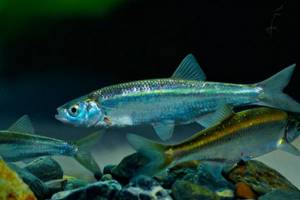
Bleak is a small fish that has a short life cycle, only 5-6 years, compared to other representatives of the carp family, such as crucian carp, which can live up to 12 years, roach with a life cycle of up to 20 years, carp, which lives about 35 years. The maximum length of the bleak is about 15 cm, with a weight of no more than 60 grams. Although rare, larger, trophy specimens are found, weighing up to 100 grams and up to 20 cm in length. The following features are considered characteristic of bleaking:
- The body is not high, but elongated, with an almost straight back and a slightly convex belly.
- The tail ends in a large dark fin with a deep notch.
- The sides of the bleak are highly compressed.
- The scales of this fish have a metallic color with a mirror shine.
- The back is gray-blue with an olive tint.
- The abdomen is light.
- The fins are distinguished by an ashen or pale yellowish tint.
A characteristic feature of bleak is that its scales can be easily removed upon contact with a hard surface. Therefore, it is not difficult to clean this fish; just grind it with salt in a large container.
Pelagic fish have a classic color scheme of dark tops and light bottoms to protect themselves from bottom predators and birds in bright conditions.
Catching
Active biting occurs from the beginning of May and lasts until the end of October. In September and October, the bite occurs at depth, but does not become less active. Bleak is not of great commercial value. Often used as bait for larger fish: pike perch, pike, asp.
Lure
To start fishing, you need to scatter the bait. It is made from bran with the addition of oatmeal, oatmeal, and coarsely ground crackers. This mixture takes the longest time to sink to the bottom, creating a cloudy cloud in the water where the fishing rod is cast.
Tackle
Properly selected gear is the key to successful fishing. To catch bleaks, use a light flexible rod 4-5 m long with a soft tip. With such a fishing rod it is easier to make a quick hook. The fishing line used is thin (0.08-0.10 mm), the hook is medium-sized (No. 14-18). A hook with a long shank and a side bend is suitable, which is better at detecting fast bites of small bleak, and is easier to remove.
Travel around Karelia
| Winter fishing | How and what to fish in winter | Fishing methods |
| Fishing rod with a nod and jig Jigs for winter fishing Selection of jigs Reelless fishing technique Winter float fishing rod Winter zherlitsa Types of winter spinners Spinner fishing technique Nozzles for winter fishing Live bait for winter fishing Devices for winter fishing Winter fishing in Karelia Notes about fishing in Karelia | The carp family - review How to catch carp in winter Catching crucian carp in winter Winter fishing for bream How to catch podust in winter Catching gudgeon in winter Winter fishing for bleak How to catch bluegill in winter How to catch roach in winter Catching dace in winter Catching verkhovka in winter Winter fishing for ide Catching asp in winter Winter fishing for rudd Fishing in winter chub | Fish and its behavior — — Roach fishing — — Bottom fishing — — We catch bream and ide — — Chub on the bottom — — We catch pike perch and trout — — Pike fishing in the spring We catch grayling — — Carp on a plug — — Summer fish stops — — We catch perch in the pond - - Fishing at depth - - Fishing with lures - - Fishing in Finland. Video. |
| About the influence of the phases of the moon on the bite of fish Encyclopedia of a young angler in pictures Main section - ABOUT FISHING | ||
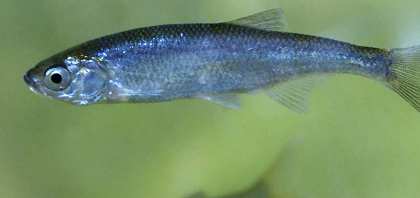
Verkhovka Verkhovka (Leucaspius delineatus) is a fish distributed almost everywhere. It can be found in all European bodies of water with little current: it does not like fast waters. This is a small schooling fish with a green back and silvery sides, with an incomplete lateral line.
It is along this “flawed” line that it is distinguished, for example, from bleak. The scales are large and fall off easily. Having taken the fish in his hands, the angler inevitably “decorates” his fingers with sparkles, which is why he has to handle it with all possible precautions. The verkhovka feeds on small invertebrates and insects that have fallen to the surface of the water. She has an upper mouth, quite adapted to such food. The size of the fish does not exceed 10 cm, which is why it will never be able to take a place on the menu “reserved” by bleak. But as for the “hunting” characteristics of the Verkhovka, it has its own advantages. This is one of the highest quality live baits, reliably bringing perch, pike perch, and pike.
Search Finding verkhovka in winter can be quite difficult. Typically, fish are located in shallows with depths not exceeding 2-3 m, in places where fresh water enters. In winter, flocks can be found almost near the shore at a depth of 0.5 m or less. This in turn leads to the approach of predators here. A fisherman usually discovers this purely by chance and is very surprised when a humpback whale tears his tackle from a depth of 35 cm. The holes must be masked regardless of the depth at which fishing takes place. It is best to do this with snow, in which a hole is pierced, allowing only a jig to squeeze through. However, some anglers have a “standard” circle made of plastic or wood with a slot for fishing line and bait.
Fishing time In the season, it is most often possible to catch the verkhovka during the thaw and on the last ice. During the day, the fish bite better from morning until noon. Fishing is most successful on calm, sunny days with slight frost or air temperatures above zero.
Fishing methods It is possible to catch the toadstool only in reservoirs with open water or near non-freezing drains. If you make a hole specially for this purpose, you will be able to lure a flock of Verkhovka here (if possible) only the next day. It is more difficult to fish with a nod fishing rod, but it is possible in almost any body of water with standing water, in bays and oxbow lakes. The fishing rod must be well adjusted. The most sensitive nod is used, fishing lines are no thicker than 0.08 mm, miniature tungsten jigs.
Bait Feeding the verkhovka is the same “jewelry” matter as fishing it. Not to feed, but to attract a flock can only be done with a carefully prepared mixture that easily disintegrates in water and contains nutritional components in completely microscopic quantities. The most suitable option is a mixture that dissolves in water to a cloudy consistency. Like all cyprinid species, the verkhovka also responds well in winter to bait of plant origin with the addition of flavorings - attractants.
Nozzles are preferably white. In this capacity, small burdock and other white and yellow larvae, obtained by fishermen from the stems of coastal grasses, are indispensable. Only the smallest bloodworms are used. The sting of the hook must be carefully masked.
Lures You need tungsten jigs with a body diameter of no more than 2.5 mm and hook No. 22 according to the international classification. Baits that work better are not round ones (such as “pellets”), but oblong ones - “droplet”, “ovinka”, “barrels”, etc. Fishing is possible without bait. But this complicates matters and in this case may only make sense as a training exercise. It is quite possible to practice the ability to work with reelless tackle on the top. If you manage to catch this fish, you can be sure of success when fishing for roach and other whitefish.
Biting and fishing Biting on the verkhovka is simple and interesting. The fish grabs the bait and tries to drag it to the side. Its vigor is such that even this clearly visible movement does not allow an awkward angler to hook it before removing the bait. Often, novice fishermen who have poor reactions manage to pull off the bloodworms one by one without being caught. Fishing is also made more difficult by the fact that it requires not just an impulsive jerk at the right moment, but a soft and at the same time lightning-fast hook with a brush and a nod. The rough movement leaves the angler with only a piece of the upper lip from the top... The catch must be lowered into the ditch carefully, trying not to touch it with your hands. After all, in the cold, touching the fish with your bare hand is tantamount to burning its skin. The man is too hot for her. With good aeration, up to 40 verkhovkas can be kept in a 10-liter volume for a very long time, and not 2-3 days, but 2-3 weeks. This is where the value of this little fish lies! When copying this material, a link to the site is required
It is worth looking at the following material:
How to insulate shoes for winter fishing. Photo. Winter fishing in Karelia (notes from an aboriginal) How to catch chub in winter How to catch rudd in winter How to catch asp in winter How to catch ide in winter How to catch dace in winter
Interesting fact
Oriental essence was extracted from bleak scales in France and used to color artificial pearls. This method was first developed in China, hence its name. The point is that a large amount of scales was placed in water, stirring until the silvery film separated and settled to the bottom. Then the scales were removed, most of the water was drained, and the silvery liquid, cleared of impurities, was mixed with fish glue. The resulting composition was used to make high-quality pearls.
Verkhovka
The fish is quite small, usually does not exceed 4–6 cm. With rather large scales and an elongated body. Upper mouth.
Pharyngeal teeth are single-row, double-row or mixed. They can be single-row on one side, and double-row on the other.
There are from 14 to 16 dense gill rakers. The lateral line is incomplete, containing no more than 14 scales. The anal fin contains from 8 to 10 branched rays. By the time of spawning, females develop a long oviduct.
The body of the fish is silvery, the back is greenish. On the sides there is a shiny stripe with a bluish tint. All fins are colorless.
In females, in front of the anal fin there is a seal formed by small and two large tubercles. In males during the spawning period, the so-called “pearl placer” is clearly visible on the head.


